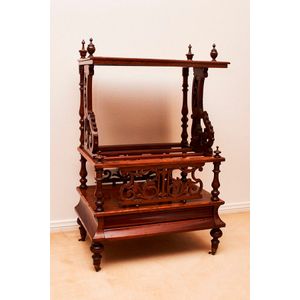19th Century Walnut Canterbury with Pierced Decoration
You must be a subscriber, and be logged in to view price and dealer details.
Subscribe Now to view actual auction price for this item
When you subscribe, you have the option of setting the currency in which to display prices to $Au, $US, $NZ or Stg.
- Veneers - Veneers are thin sheets of well-figured timber that are glued under pressure to the surface of a cheaper timber for decorative effect, and then used in the making of carcase furniture.
Early veneers were saw-cut so were relatively thick, (up to 2 mm) but is was realised that saw cutting was wasteful, as timber to the equivilent of the thickness of the saw was lot on each cut.
A more efficient method was devised to slice the timber, either horizontally with a knife, or in a rotary lathe.
Flame veneer, commonly found in mahogany or cedar furniture, is cut from the junction of the branches and main trunk. So-called fiddleback veneers, where the grain is crossed by a series of pronounced darker lines, is usually cut from the outer sections of the tree trunk.
During the 17th and 18th centuries, and in much of the walnut marquetry furniture made during the latter part of the 19th century, the veneer was laid in quarters, each of the same grain, so that one half of the surface was the mirror image of the other.
The use of veneer allows many other decorative effects to be employed, including stringing, feather banding, cross banding, and inlaid decorative panels in the piece. The carcase over which veneer is laid is usually of cheaper timber such as pine, oak or, sometimes in Australia during the first half of the 19th century, red cedar.
The important thing to remember about veneers is that prior to about 1850 they were cut by hand, and were consequently quite thick - ranging up to about 2mm deep.
From the mid-19th century veneers were cut by machines and were almost wafer-thin. This is a critical point when trying to judge the approximate age of veneered furniture.
This item has been included into following indexes:
Visually similar items

A Victorian walnut canterbury whatnot, rectangular shape, the top with a fretwork gallery, raised on turned supports from a canterbury base with fretwork panelled sides and a single drawer in the frieze, raised on turned legs with white porcelain casters.

Victorian burr walnut music canterbury, with one shelf and recessed drawer below, height 86 cm width 58 cm depth 37 cm. Provenance: Private Collection, Double Bay, NSW

A Victorian burr walnut whatnot canterbury, mid 19th century, the shaped tiered whatnot of typical form with spindles, finials, ribbon twist supports and fretwork embellishments, the lower tier with pierced compartments above an apron drawer and raised on

Victorian burr wood music canterbury, the rectangular top with pierced gallery and ornate side supports, with slatted partitions and a drawer below (A/F), height 90 cm. Provenance: The Estate of the late Janis Salisbury, Sydney
